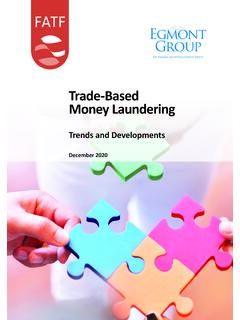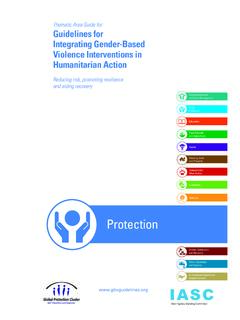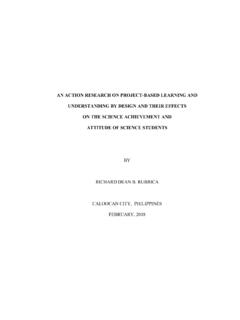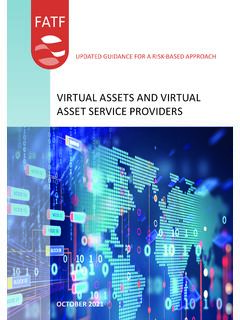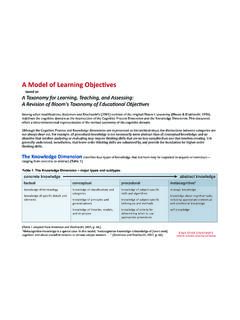Transcription of Beyond Science-Based Targets: A BLUEPRINT FOR …
1 Beyond Science-Based Targets: A BLUEPRINT FOR CORPORATE. action ON climate AND NATURE. December 2020. Primary Authors: WWF: Brad Schallert, Martha Stevenson, Chris Weber, Alex Farsan BCG: Jesper Nielsen, Paulina Ponce de Le n, Nicholas Collins Key Contributors: WWF: Josefina Brana-Varela, Tim Juliani, Mark Griffiths, Christa Anderson, Lloyd Gamble, Evan Carlson, Mandy Jean Woods BCG: Michel Fr deau Acknowledgements: WWF: Milan Kooijman, Johanna Myrman, Vanessa Perez Cirera About WWF. World Wide Fund for Nature (WWF) is an independent conservation organization, with over 30 million followers and a global network active in nearly 100 countries. Our mission is to stop the degradation of the planet's natural environment and to build a future in which people live in harmony with nature, by conserving the world's biological diversity, ensuring that the use of renewable natural resources is sustainable and promoting the reduction of pollution and wasteful consumption.
2 Find out more at About Boston Consulting Group Boston Consulting Group partners with leaders in business and society to tackle their most important challenges and capture their greatest opportunities. BCG was the pioneer in business strategy when it was founded in 1963. Today, we help clients with total transformation inspiring complex change, enabling organizations to grow, building competitive advantage, and driving bottom-line impact. To succeed, organizations must blend digital and human capabilities. Our diverse, global teams bring deep industry and functional expertise and a range of perspectives to spark change. BCG delivers solutions through leading-edge management consulting along with technology and design, corporate and digital ventures and business purpose. We work in a uniquely collaborative model across the firm and throughout all levels of the client organization, generating results that allow our clients to thrive.
3 Find out more at Publication date: December 2020. Editor: Edward Baker Design: Copyright 2020 World Wide Fund For Nature (formerly World Wildlife Fund), Gland, Switzerland and Boston Consulting Group. Any reproduction in full or in part must mention the title and credit the above-mentioned publishers as copyright owners. WWF International, Rue Mauverney 28, 1196 Gland, Switzerland Tel. +41 22 364 9111. Boston Consulting Group 200 Pier 4 Boulevard Boston, Massachusetts 02210. United States Tel.+1 617 973 1200. For enquiries: Cover photography: Voyata / Jacques Tarnero / Contents INTRODUCTION 4. CORE RATIONALE FOR A NEW BLUEPRINT 5. THE CORPORATE climate MITIGATION BLUEPRINT 6. 1. ACCOUNT AND DISCLOSE EMISSIONS 8. 2. REDUCE VALUE CHAIN EMISSIONS, IN LINE WITH A. Science-Based TARGET PATHWAY 8. 3. QUANTIFY A FINANCIAL COMMITMENT BY PRICING. REMAINING EMISSIONS 9. 4. INVEST THE FINANCIAL COMMITMENT FOR climate . AND NATURE IMPACT 10.
4 MAXIMIZING VALUE ACROSS BUSINESS GOALS AND CO-BENEFITS 12. ADDITIONAL ELEMENTS OF CORPORATE climate STRATEGY 13. NEXT STEPS 14. ANNEX 1: ALIGNING WITH NET-ZERO TARGETS 16. ANNEX 2: CONSIDERATIONS FOR NATURE based SOLUTIONS 17. ANNEX 3: DIMENSIONS OF CARBON CREDIT QUALITY 18. Neil Ever Osborne / WWF-US. INTRODUCTION. Every day, more companies large and small are proudly announcing their voluntary commitment to climate action . Many are promising significant reductions in their greenhouse gas emissions, greater transparency into their carbon footprints, plans to become net-zero by or before 2050, and other climate goals. In parallel, there is increasing interest in investing in nature- based solutions as a key pillar for climate ambition. This momentum is driven by companies' determination to play their part in stopping global climate change, as well as an understanding of the competitive advantages to be gained.
5 Yet even companies with the best intentions face considerable hurdles when setting climate goals, crafting climate strategies, and communicating them to the public. Because Jean-Marie Hullot / Flickr these voluntary initiatives are taking place in an emerging and fast-evolving field, companies often struggle to translate scientific consensus and knowledge ( , IPCC reports1), as Companies that successfully integrate an effective climate well as government commitments ( , Paris Agreement), response into their core business strategy will be able to into meaningful corporate climate strategies and actions. generate value. We're seeing corporate leaders respond to the Inconsistent corporate claims about climate action ( , climate challenge in a way that helps reduce costs, grow their net-zero, carbon positive, carbon negative, climate neutral, business or capture price premiums, as well as maintain or etc.) only add to the noise and confusion, while raising extend their license to operate.
6 Investors increasingly favor doubts among stakeholders as to the credibility of individual and value clear action on climate change they recognize companies' climate The risk of being accused of that companies are building competitive advantage and long- greenwashing' is ever-present, as is uncertainty as to whether term resilience. By implementing the actions recommended specific corporate actions are truly advancing climate goals, in this BLUEPRINT , companies will not only truly advance their nature goals, both, or neither. climate and nature goals. They'll become part of the solution, delivering value for all investors and society as we work This paper introduces the Corporate climate to secure a net-zero world. Mitigation BLUEPRINT in hopes of cutting through the noise and focusing on the actions that can underpin We must, however, keep in mind that this BLUEPRINT is only a truly effective corporate strategy for mitigating a piece of corporate sustainability strategies, which must the effects of climate change and protecting nature.
7 Encompass all environmental impacts from companies This BLUEPRINT is framed in the context of broader corporate and avenues for leadership on key elements such as water, climate efforts, and thus also highlights three additional biodiversity, and ecosystem conversion and degradation. critical elements which must be done in parallel advocating Guidance as to how companies can complement their climate for climate policy such as carbon pricing and sector-specific strategies with broader nature strategies can be found in incentives, collaborating with peers to achieve lasting climate the Science based Targets Network's Initial Guidance for progress, and improving company and ecosystem resilience Business and through other leading platforms in the matter in the face of global warming. such as the Business for Nature coalition, amongst others. 1 An element of confusion has been interpretation of pathways from IPCC's Special Report on Figure from this report clearly reflects that all viable C.
8 Pathways (across SSP 1, 2 & 5) require deep emissions reductions. They all also require negative emissions ( , removals), but not until the 2040 time frame. Often interpretation will jump to needing to start land removals now as trees need time to grow but time is also an important factor for fossil fuel emissions, as all of the pathways reflect that the earlier the fossil fuel emissions are reduced, the fewer removals will be needed later. It is important to look at the full picture of these results and what they will require. 2 Corporate climate claims and future climate commitments vary significantly between companies, both in terminology and meaning. Common examples include Carbon Neutral, climate Neutral, Net Zero, climate Positive, climate Negative, and 100% Green. Key variations behind these claims include: type of pollutants covered ( , carbon only vs. Kyoto gases, vs. broader climate and/or nature impacts); extent of value chain coverage ( , scope 1 commitments vs.)
9 Scope 1-3 commitments); timeframe of emissions covered ( , annual emissions vs. lifetime company emissions); mitigation levers utilized ( , abatement only, abatement + CO2 removal credits only, abatement + any type of credit); and degree of climate /nature positivity ( , mitigating more than the company's annual footprint, investing Beyond mitigation and supporting other nature, biodiversity or social goals). These variations risk obscuring the true ambition of companies climate strategies, and making it difficult to track progress against goals. Beyond Science-Based TARGETS: A BLUEPRINT FOR CORPORATE action ON climate AND NATURE. CORE RATIONALE FOR A. NEW BLUEPRINT . A new model for corporate climate action is needed for a number of reasons, but they can be boiled down to one key meta-problem a mismatch between the current solution set available and the scale of the problems they are trying to solve. Existing Footprint- based ' approaches ( , carbon Redirecting businesses - and our economy toward a accounting, life cycle assessment) are attributional' and net-zero and nature positive' future is the challenge of our backward-looking.
10 They focus on the question what is my lifetime: we need $75 trillion in investments3 to deliver company's responsibility for GHG emissions in the previous on the Paris Agreement, plus tremendous ingenuity and year? This reductionist approach has been and continues willingness to change. The response must build on each to be a critical component of corporate accountability. It other's efforts over a long-time horizon with companies is the basis for today's leading corporate climate mitigation simultaneously reducing their own operational emissions, standard the Science based Targets Initiative (SBTi) but decarbonizing their value chain, driving innovation to it is only one component of what could be a more holistic create future solutions for harder-to-abate emissions and solution for corporate climate strategies today, where the engaging consciously and constructively on how to reach focus is also about looking forward.

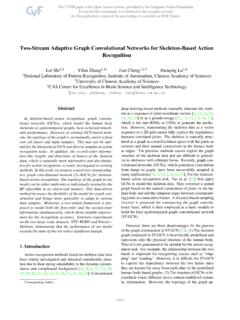
![arXiv:1801.07455v2 [cs.CV] 25 Jan 2018](/cache/preview/c/1/f/1/b/a/a/5/thumb-c1f1baa5f6e090b207f4f18380d23ecd.jpg)

